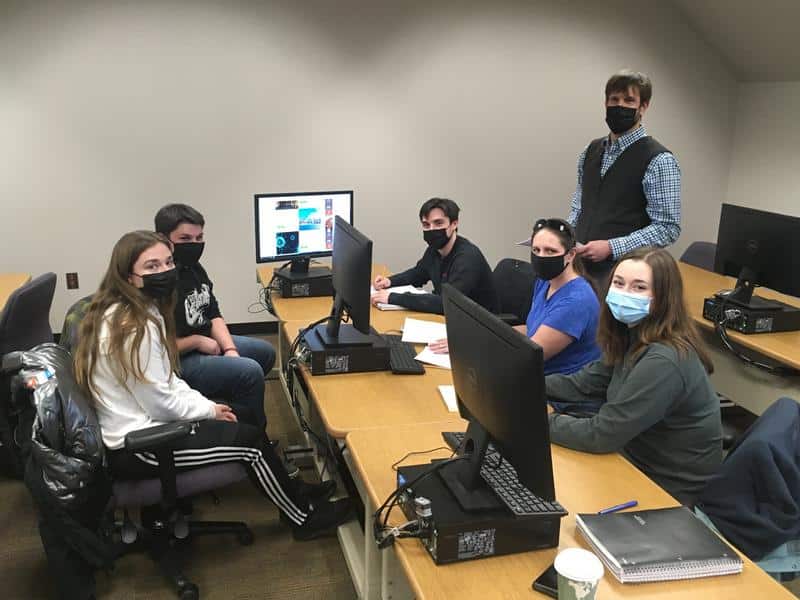*As published by Green Energy Times, February 11, 2022
Vermont Tech’s Architectural Engineering Technology and Renewable Energy programs both include a senior capstone project, wherein students apply what they have learned in coursework toward solving a problem, capitalizing on an opportunity, or fulfilling some need. The programs both include a focus on energy issues. This year, the two programs have joined forces, challenging students to design a performing arts center in Sydney, Australia. VTC seniors will not only design the building systems, but they will apply renewable energy sources to attempt a net-zero design for the structure.
Their effort is part of the American Society of Heating, Refrigerating, and Air-conditioning Engineers (ASHRAE) 2022 Student Design Competition. The VTC students are entering the “Integrated Sustainable Building Design” option in the competition, where they will develop schematic-level designs of the architectural, mechanical, electrical, lighting, structural, civil, and site systems for a large performing arts center to be located in Sydney, Australia. The building comprises performance areas, office spaces, classrooms, food service, parking, and other uses in three levels, totaling 250,800 square feet (23,300 square meters).
The design should be environmentally friendly and meet energy-efficiency criteria from ASHRAE and others. Students will consider various heating, cooling, and ventilating systems, electrical systems and lighting technologies, and innovative materials, to be energy-efficient with a low carbon footprint (plus creating an effective, aesthetically pleasing look and comfortable conditions for employees and patrons. It is important to note that, the team will attempt to provide sufficient energy from local or on-site renewable sources to offset the building’s energy use, resulting in net-zero status. An energy production plan may include solar, geothermal, and tidal applications, among others. This marriage of energy-efficient design and renewable energy production highlights the strengths of the two programs at VTC, where Architectural Engineering Technology students bring their capabilities in optimal building system design together with Renewable Energy students’ expertise in energy use and production.
The team will spend the beginning of the semester researching Sydney, Australia and the building owner’s project requirements. They already have developed a schedule and budget for their design work. After they consider the advantages and disadvantages of various building and energy-production systems, including their sustainability and ability to be integrated effectively, they will select specific systems to pursue further, and perform the calculations and other work necessary to bring all of the building systems designs to a schematic level, along with their energy plan. They will perform an economic analysis of their design, using state of the practice tools such as heating and cooling load calculators. Their submission to the ASHRAE competition in May will include a video, a technical report documenting their engineering and architectural work, and appropriate design drawings. The team will present its project to the public on VTC’s Randolph Center campus, tentatively scheduled for May 6, 2022 (along with another Architectural Engineering Technology team focusing solely on an in-depth structural design of the same building).
The students will be guided by Scott A. Sabol, P.E., who is a full-time faculty member in the Architectural Engineering Technology program, and Nathan Mascolino, P.E., who is an adjunct faculty member whose primary employer is VEIC, an energy-solutions firm closely tied with Efficiency Vermont.
The idea to combine seniors from the two programs this year came from Professors John Kidder and Dan Costin (who directs the Renewable Energy program). Buildings represent a significant consumer of the world’s energy, and energy-efficient design alone will not be sufficient to meet Vermont’s goals. The ability to provide sustainable energy for buildings (as well as for other uses) from nontraditional sources is an additional keystone to Vermont’s and the world’s future. Professor Costin stated, “The 2021 Infrastructure Bill is going to invest billions of dollars in electrical transmission, renewable energy projects, battery storage, and electrical vehicle infrastructure. VTC is prepared to educate and train the workers who will design and build many of these systems. In fact, we have been doing that for years. Our problem in Vermont is that there are not enough workers for these technical jobs, and not enough students getting educated to meet the demand of renewable energy businesses around the state.”
More information about the ASHRAE student design competition can be found on their website and information about the course project, including the public presentations, can be obtained from Professor Sabol (ssabol@vtc.edu). Anyone seeking information about the Renewable Energy program should contact Professor Costin (dcostin@vtc.edu), and should contact Professor Brad Miller, P.E., about the Architectural Engineering Technology program (bmiller@vtc.edu).
